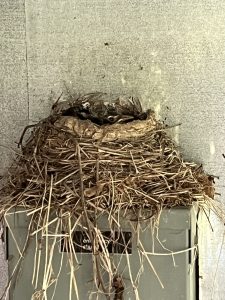
Goodness it’s been hot. What did you have out for birds in your backyard to beat the heat? We have multiple types of cover (shade and safety) and water as well. These robins used the roof of one our sheds as their shade.
July Bird List
- Blue Jay
- Mourning Dove
- Red-winged Blackbird
- White-breasted Nuthatch
- Ruby-throated Hummingbird
- American Goldfinch
- Northern Cardinal
- Tufted Titmouse
- Downy Woodpecker
- Song Sparrow
- Dark-eyed Junco
- Rose-breasted Grosbeak
- Yellow-bellied Sapsucker
- Hawk spp. (Red-tailed?)
- Hairy Woodpecker
- American Robin
- Eastern Phoebe (seen on bridge to entrance)
- Black-capped Chickadee
- Black-and White Warbler (it perched on one of the feeder arches and a Rose-Breasted Grosbeak startled it off)
- Gray Catbird (on bridge railing)
- Common Yellowthroat (both male and female perching on the bee balm and the little willow)
- Red-bellied Woodpecker
(Bold items in this list are species not recorded in June 2025.)
Other wildlife: Hummingbird moths (Snowberry Clearwing); bees of various (unidentified) kinds, Eastern Chipmunks, Monarch butterflies (and other species); American Toad.
Below is a link for all official eBird observations on the Museum’s property — from the viewing window and elsewhere, across all years of observations: https://ebird.org/hotspot/L282687 . Just for fun and cross-reference, this next link brings you to the iNaturalist records of birds at the Birds of Vermont Museum : https://www.inaturalist.org/places/199495#taxon=3
Want to go look for birds with us? Register for one of our upcoming events or visit to the Museum. See you soon!
If you follow us on Facebook and/or Instagram, you’ll find us talking about bird news, sharing photos, suggesting events, and more. Check us out! We are currently most active on Instagram. We’ve got a Bluesky profile but haven’t posted much yet. Working on it!
The “Through the Window” series is an informal record of observations made by staff, volunteers, and visitors. Anyone at the Museum may add to this list. Observations are usually through our viewing window: a large window with a film covering that helps hide watchers from the birds. We have chairs and binoculars to try, a white board, and many identification guides. Outdoors, several feeders are attached on a single, 8′ steel pole. A small pond, flowers and water plants, shrubs and trees add cover and (seasonally) other food choices.
